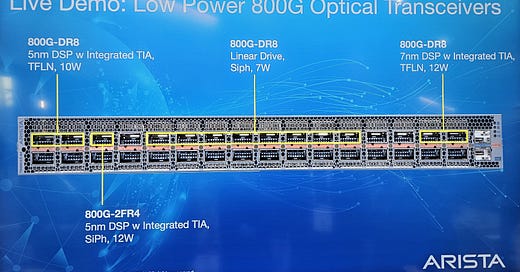Marvell's DSP Dilemma? Networking’s Tectonic Shift Led By Broadcom, Nvidia, Arista Networks, Microsoft, Meta, Macom, and more
Will Marvell's Strongest Moat Be Breached? $MRVL $AVGO $NVDA $ANET $MSFT $MTSI $META
The networking industry could be undergoing a tectonic shift with buy-in from many members of the supply chain… except Marvell. The change would directly lower latency, power, and cost for the most data-hungry workloads including machine learning training and inference of generative AI models, but also general compute. Marvell’s most transformative acquisitions over the last few years was of Inphi, the leader in PAM4 DSPs (Digital Signal Processors), TiAs (Transimpedance Amplifiers), and drivers. Optical networking speeds within the datacenters have made incredible strides, thanks to Inphi and now Marvell.
It’s not all roses and sunshine though. All the other titans in networking including Broadcom, Nvidia, Arista Networks, Microsoft, Meta, Macom, and many others are rallying toward designing Marvell out. This attack on Marvell’s tremendous profitability in networking isn’t only a frontal assault, but moreso death by a thousand cuts. Some of these thousand cuts against Marvell could even be described as “Samurai Slashes” given the market share in various segments these competitors hold. Marvell isn’t taking this sitting down, and they are fighting back.
The biggest question is where technology roadmaps, deployments, market share, and revenue share goes. Today, we want to answer these questions and discuss the numerous challenges facing Marvell that could knock their current dominance down a couple of pegs.
Before we dive into the business implications and changes in technology, first let’s explain the basics of datacenter networking. If you already know this, scroll down to “The War On Marvell” section. The majority of this post is about the current and future market/technology.
Pretty much all communications in the datacenter beyond a handful of meters use optical fiber. Networking chips such as switches will have ports at the back of a server where a module called a transceiver converts electrical signals into optical. There are 6 critical components in this module.
DSP (Digital Signal Processor): The DSP takes serialized inputs from the switch ASIC, converts them from analog to digital, and performs various functions such as signal conditioning, equalization, error correction, and clock/data recovery. It then converts these digital signals back to analog and pushes them forward.
Drivers: The driver receives an analog input and provides the necessary electrical current and voltage to the laser to generate the required optical signal.
Laser: The laser is responsible for emitting light at a specific wavelength, and its intensity can be modulated to encode data onto the optical signal.
Transmit Optics: The transmit optics are responsible for shaping and directing the optical signal generated by the laser into the fiber. They can include lenses, mirrors, and other optical components. They can modulate the signal too depending on the architecture of optics.
Receive Optics: The receive optics are responsible for receiving and focusing the optical signal transmitted over the network onto a photodiode. They can include lenses, mirrors, and other optical components that direct the incoming optical signal onto the photodiode.
TIA: The TIA converts the current signal generated by the photodiode on the receive into a voltage signal. It amplifies this signal to improve its signal-to-noise ratio before sending it to the DSP (Digital Signal Processor) for further processing.
There are numerous different technologies for optical formats, but the 3 more important ones within the datacenter are the following. They are all based on 100G per lambda (color of light). Use this as a quick guide.
AOC 400G/800G – The number stands for how many transmit and receive pairs there are. AOC is the shortest range standard at only 30 meters to 100 meters max, but also has the lowest power. It uses cheaper multi-mode fiber and directly driven VCSEL lasers.
DR4/DR8 400G/800G – There are 4 or 8 transmit fibers and a corresponding number or receive fibers, a total of 8 or 16 fibers. It uses single-mode fiber. Various versions of this standard exist with a max reach of 500 meters to 2km.
FR4/2xFR4/FR8 400G/800G – These modulate wavelengths of light on a single-mode fiber. Various versions exist with a max reach of 2km to 10km. This standard is the highest power due to loss from multiplexing light onto a fiber.
Next, let’s talk about what’s being done by the other networking titans that could severely weaken Marvell’s position in the market. This includes Broadcom, Nvidia, Arista Networks, Microsoft, Meta, Macom, Intel, Maxlinear, Coherent, Credo, Poet, Innolight, Hisense, Alphawave, Semtech, Accelink, Colorchip, Coherent, Eoptolink, Applied Optoelectronics, and Cloud Light.





